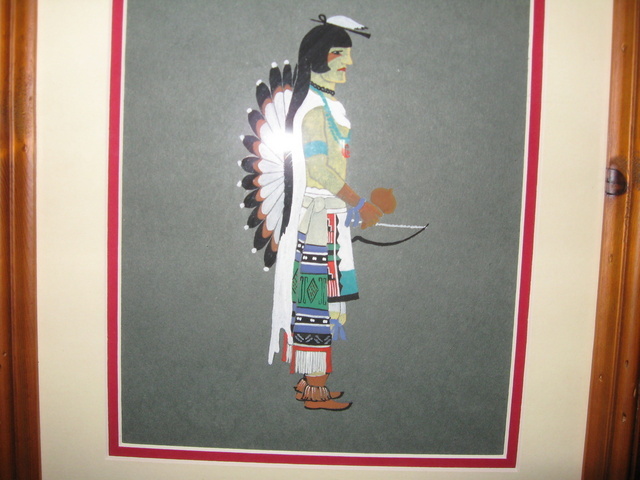
For Collectors of International Art
We specialize in the Art and Artists of New Mexico
If you would like information on Paintings by Virginia More Roediger currently for sale..... please email:
Education: School of Drama at Yale University
Ms. Roediger began studying Pueblo dances in 1925 when she drove out west for college. She wrote Ceremonial Costumes of the Pueblo Indians as her dissertation in the School of Drama at Yale University.....Virginia More Roediger's Ceremonial Costumes of the Pueblo Indians: Their Evolution, Fabrication, and Significance in the Prayer Drama was first published in 1941 and reprinted, with black-and-white illustrations, in paperback two decades later. It soon went out of print. The reappearance of the classic original edition in full color was a welcome event....this comprehensive, illustrated volume explores Pueblo costumes and the theatrical ceremonies in which they are used. .....
When the University of California Press first published Roediger's Ceremonial Costumes of the Pueblo Indians in 1941, it was immediately hailed as both a beautiful book and the most comprehensive description ever of the making and meaning of the Pueblo costumes of New Mexico and Arizona. It has been widely acknowledged as a classic and eagerly sought after in antiquarian bookstores. Exactly fifty years after its original publication, here is the book back in print, with a new introduction by the renowned anthropologist Fred Eggan. Roediger's vivid paintings are reproduced once more in full color, capturing the beauty and drama of the Pueblo ceremonies--the turquoise dance moccasins, the tableted headdress of the Zuni corn maidens, the bright-blanketed Kachina maiden, and the buffalo, brilliant eagle, and horned deer costumes.
It was Roediger who first viewed the ceremony and ritual of the Pueblo peoples as dramatic performance, a view that has gained great currency since. As a student of drama at Yale University she was fascinated by the intensely theatrical dimension to Pueblo worship, and it is this original perspective that informs and illuminates her study.
After a brief survey of the history, location, and life of the Pueblo peoples, Roediger embarks on a thorough analysis of the materials used in the Pueblo costumes. She explains both their symbolic significance and their manufacture--from the weaving of cloth and the tanning of leather to the preparation of birds' feathers, evergreens, paints, and dyes. She then provides a meticulous description of the costumed dancer--body paint, garments, ornaments, accessories, and dance properties such as rattles, headdresses, and masks.
In her final section, Roediger explores the relation of the costumes to the prayer dramas, particularly to the reverential, solemn, ecstatic public dance with which these climax. Vivid details emerge here about such rituals as the animal dances from the Rio Grande region and the Rain Dance of the Zuni.
Fifty years after its original publication, Virginia Roediger's book remains the most comprehensive study of the ceremonial costumes of the Pueblo peoples. A book of great visual appeal and unrivaled detail, it will be welcomed back by scholars and general readers alike.
Virginia More Roediger began studying the Pueblo dances in 1925 when she drove out west for college. She wrote Ceremonial Costumes of the Pueblo Indians as her dissertation in the School of Drama at Yale University. Fred Eggan is Professor Emeritus of Anthropology at the University of Chicago and the author of, among others, The Social Organization of the Western Pueblos (Chicago 1950) and The American Indian: Perspectives for the Study of Social Change (Cambridge 1981)
Minor shelfwear. Unread. Paper. 25 Full Color Figure Illustrations plus 40 Full-Color Plates. Map. Preface. Author's Preface. Introduction. Appendix: Pueblo Linguistic Groups. Notes. Bibliography. 251 pp. 7 5/8" x 11." 2 lb. 5 oz. OUT OF PRINT.
Classic. Virginia Roediger's vivid paintings are reproduced in full-color 50 years after their initial publication, with a new introduction by renowned anthropologist Fred Eggan. She captures the beauty and drama of Pueblo ceremonies -- the turquoise dance moccasins, tableted headdress of the Zuni corn maidens, bright-blanketed Kachina maiden, and the buffalo, brilliant eagle, and horned deer costumes. After a brief survey of the history, location, and life of the Pueblo peoples, Roediger embarks on a thorough analysis of the materials used in the Pueblo costumes. She explains both their symbolic significance and their manufacture -- from the weaving of cloth and tanning of leather to the preparation of birds' feathers, evergreens, paints, and dyes. She then provides a meticulous description of the costumed dancer -- body paint, garments, ornaments, accessories, and dance properties such as rattles, headdresses, and masks. In her final section. Roediger explores the relation of the costumes to the prayer dramas. (University of California Press)
"An imaginary time machine is not the only instrument by means of which we may be carried into the past. The past lies near to our doors if only we will open our eyes and take notice of it Amid the mechanical wonders and terrors of this generation cultural relics exist which have been passed down from age to age relatively unaltered since first the continent of America was discovered, explored, and colonized. In the homes of the Pueblo Indians of New Mexico and Arizona part of man's history is enshrined." (opening, Preface by Allardyce Nicoll) c. 1991 Regents of the University of California
This wonderful volume is a product of the 1930s. Pueblo history, linguistics, and culture have had much more recent study rendering some of the background information here dated. Eggan's excellent Introduction puts this into focus. Reprint of UCLA Press, 1940, 1st ed. --Frances